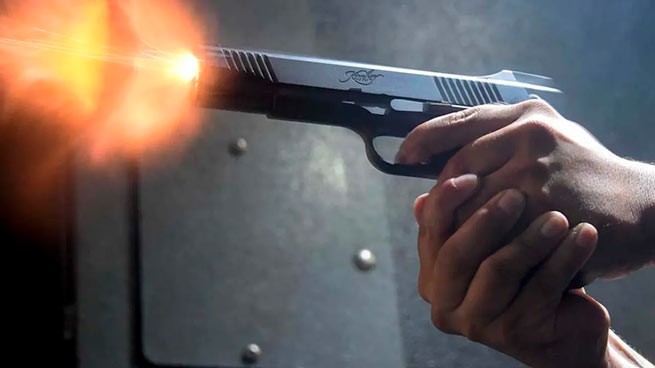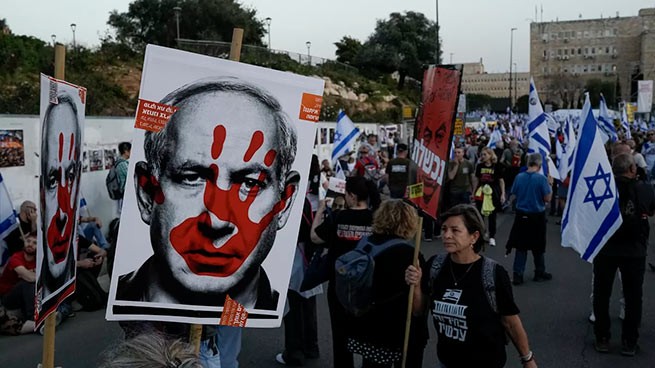On July 15, 1974, the junta of the Black Colonels, which is living out its last days in Greece, tried to change the government in Cyprus before its final disappearance into oblivion.
No matter how good the intentions of the then Greek leadership were, the result of this unpleasant story was the invasion of the Turkish army into the territory of Northern Cyprus and the proclamation of a new, unrecognized, but very real republic.
Residents of Cyprus this morning (July 15), at 8:20, heard the sound of a civil defense siren. This signal is repeated every year to commemorate the events that eventually led to the Turkish invasion and the partition of the island. It was at these minutes 42 years ago that the residence of the President of Cyprus, Archbishop Makarios III, was attacked from two directions by the special forces of the Cypriot National Guard, with the support of the military contingent of the Greek army stationed in Nicosia. 650 rebels and 40 armored vehicles, including Soviet T-34 tanks, opened fire on the presidential palace with all types of weapons. The attackers were opposed by about 150 bodyguards and police officers.
Film reenactment of the storming of the presidential palace, filmed as part of a documentary film about the coup
Makarios himself arrived from Troodos only 10 minutes before the start of the assault and at the beginning of the coup met with a delegation of Egyptian schoolchildren. In a matter of minutes, the fighters of the presidential guard, led by Makarios’s nephew (Cyprus, however, is a very conservative society, for security reasons, the president’s relatives were also a cook and a driver), managed to take the head of state and the children out through the back exit to the road, from where he got to Kykkos monastery safe and sound. At the same time, the residence of the Archbishop of Cyprus, whose post Makarios combined with the presidential one, was fired upon and seized. All this was preceded by a rather lengthy confrontation between the Cypriot government and the Greek junta in Athens.
Consequences of the battle for the presidential palace
Makarios, who became the first president of the Republic of Cyprus in 1960 and managed to be three times elected to this position by 1973, was not at all such a consistent supporter of the island’s annexation to Greece (enosis), as it looked during the years of the struggle against British rule. The radical part of the former associates of the president, including the notorious general Grivas Digenis, openly spoke out for the removal of Makarios from power. The strongest support for these forces was provided by the junta of “black colonels” who came to power as a result of the military coup on April 21, 1967.
Consequences of the battle for the presidential palace
By July 1974, the President of Cyprus had already survived two unsuccessful assassination attempts, including shelling a helicopter during takeoff from the presidential palace on March 8, 1970. While climbing, the car was subjected to machine gun fire from the roof of an adjoining gymnasium. The seriously wounded pilot managed to land the helicopter right on the street not far from the residence, from where the archbishop personally took him to the hospital in his presidential car and stayed there throughout the entire operation to save the pilot’s life. After that, making sure that nothing threatened the pilot’s life, Makarios went by car to the Macheras monastery, where in the morning his service was scheduled in honor of the EOKA heroes who died in the struggle for the independence of Cyprus.
Makarios shortly after the assassination attempt
In total, more than 90 people were killed and about 250 were wounded in the battles on the morning of July 15, 1974, with the resistance of the units remaining loyal to the legitimate head of state that followed the storming of the palace.
After capturing the palace, the rebels announced the death of President Makarios and the dissolution of the government. Makarios, who was at that time in the Kykkos monastery, recorded a radio message, which was already broadcast by a private radio station in Paphos at 13:00. In the text of his speech, Makarios emphasized that he is alive and continues to be the President of the Republic of Cyprus: “The Greek Cypriot people! You know the voice that you hear. You know who speaks. It is I, Makarios. The one you have chosen to be your leader. . I am not dead, as the Athenian junta and some of its representatives inform about it. I am alive. And I am with you, ally and standard-bearer in our common struggle. “At 15:00 the putschists announced the president of Nikos Samson, a radical journalist and member of parliament, who the organizers of the coup planned to win over to their side.
The attempted military coup was preceded by an attempted coup of the church, when on March 2, 1973, during a meeting of the Holy Synod, three metropolitans – Gennadios, Antemios and Kyprianos – demanded that Archbishop Makrios resign from the presidency. A long struggle in the church over the next year led to the addition of the ranks of the rebellious metropolitans. One of the very first steps of the junta, which declared itself the winner, was the appointment of the disgraced Gennadios as Archbishop of Cyprus.
Tank T-34 putschists at the police station in Nicosia.
The preparations for the coup were under the direct control of the Greek military junta. The death of Digenis as a result of a heart attack only intensified the pro-Greek mood in the army elite, from where Makarios consistently demanded the removal of the Greek officers. The coup was preceded by a long struggle between Makarios and the Greek junta, with lengthy negotiations and mutual claims. It was the position of Makarios that served as the trigger in the organization of the putsch, which was supposed to complete the long-standing plans to annex Cyprus to mainland Greece.
On the morning of July 16, Makarios left the location of the Finnish UN battalion in an English helicopter and went to the British military base Akrotiri, from where he flew by plane through Malta to London.
Before the start of the operation of the Turkish armed forces “Attila” on the morning of July 20, there were less than 4 days left ….
Cyprus, which was part of the British colonial possessions, gained independence August 16, 1960… The 1959 Zurich-London agreements, which significantly limited the sovereignty of the republic, became legal registration. Under these agreements, Great Britain, Greece and Turkey were declared the guarantors of the “independence, territorial integrity and security” of Cyprus, which provided these states with the opportunity to interfere in its internal affairs (“Treaty of guarantees”). In addition, Greece and Turkey received the right to keep their military contingents on the island – 950 and 650 people, respectively. (“Treaty of Alliance”). England retained in Cyprus, under its full sovereignty, an area of 99 square miles, on which there are two large military bases – Dhekelia and Akrotiri. It also secured the right to use other “small areas” and infrastructure in connection with the activities of bases and facilities.
July 15, 1974, with the support of the Greek military junta, a military coup took place on the island. President Makarios was removed from power, and control of the island passed to Nikos Sampson, a representative of the Greek underground organization EOKA-B, which advocated the annexation of Cyprus to Greece – Enosis. The putschists seized the capital’s airport, radio station, the presidential palace, and a number of administrative institutions in Nicosia and established their power. Under the pretext of the impossibility of a peaceful settlement of the conflict and the protection of the Turkish community, the Turkish government sent its troops to Cyprus.
At dawn on July 20, about 30 Turkish landing ships and boats, having made the transition from the Turkish port of Mersin, started landing amphibious assault forces in the area 5-7 km west of the city of Kyrenia, and Turkish airborne assault forces were landed in the areas to the south. By the end of the day, up to six thousand troops were deployed to Cyprus, and in the next few days the number of the Turkish corps was increased to 40 thousand people. They were armed with 300 tanks, a thousand armored personnel carriers and many other military equipment.
Developing an offensive on Kyrenia and Nicosia, Turkish troops fought intense battles with units of the Cypriot National Guard, widely used tanks, artillery and aircraft. Ships of the Turkish Navy blocked the southern ports of the island – Limassol and Paphos, preventing the transfer of Greek troops by sea. On July 21, Greek ships, landing and transport vessels in the Paphos region were attacked by Turkish aircraft and ships, during the naval battle they suffered heavy losses. By the end of July 21, Turkish troops captured Kyrenia, established control over the Kyrenia-Nicosia road, seized the capital’s airport and began hostilities on the northern outskirts of Nicosia.
On July 20, the UN Security Council demanded the restoration of the sovereignty and territorial integrity of Cyprus, the constitutional structure and legal government of the republic, a ceasefire and the withdrawal of foreign troops from the island, calling on Greece, Turkey and Great Britain to begin peace talks on Cyprus.
On July 22, 1974, the ceasefire clause entered into force. In Geneva on July 25-30 and August 8-14, two conferences on Cyprus were held to no avail. On August 14, Turkish troops, in order to expand the occupied territory, resumed their offensive from the Nicosia area to the east and west. The aircraft attacked the troops, radio stations and other important targets of the Greek Cypriots in the capital. By the end of August 16, Turkish troops reached the so-called Attila line, proposed by the Turkish government as the border between the Turkish and Greek parts of the island. They took control of the cities of Famagusta, Bogaz, Morphu and others.
On August 18, 1974, the fire was stopped.
As a result of these events, Turkish troops occupied about 37% of the island’s territory, which led to its actual split into two separate parts, which continues to this day. The country’s economy was disorganized, and communications between communities were completely disrupted. According to the UN, the total number of displaced Greek Cypriots amounted to 198 thousand people, Turkish Cypriots – 37 thousand people. In 1974-1975, an “exchange” of population took place: Turkish Cypriots almost completely moved to the part of Cyprus occupied by Turkish troops, and Greek Cypriots – to the south of the island.
On February 13, 1975, the leadership of the Turkish community unilaterally proclaimed in the northern part of the island the so-called “Turkish Federal State of Cyprus”, of which Rauf Denktash was elected “the first president”.
November 15, 1983 the legislative assembly of the “Turkish federal state of Cyprus” unilaterally proclaimed the so-called independent Turkish-Cypriot state, which is called the “Turkish Republic of Northern Cyprus” (TSRC). It has not yet been recognized by anyone other than Turkey. The TRNC is separated from the rest of Cyprus by a buffer zone. The line dividing the island into two sectors (the so-called Green Line) is guarded by a contingent of the United Nations Peacekeeping Force in Cyprus (UNFICYP). The “Green Line” also passes through the historical center of the island capital of Nicosia – the tourist and shopping street Ledra.
The UN Security Council in resolution 541 (1983) condemned this step and called on all UN member states to “respect the sovereignty, independence, territorial integrity of the Republic of Cyprus”, “not to recognize any Cypriot state except the Republic of Cyprus.” This position was reaffirmed in UN Security Council Resolution 550 (1984), which called on “not to assist or render any assistance to the separatist entity” in the north of the island of Cyprus.
Since 1975, the UN Secretary General has been carrying out a “good offices” mission in Cyprus entrusted to him by the Security Council, with the aim of assisting the Greek and Turkish communities of the island in the interests of a peaceful settlement of the Cyprus problem.
The coup failed after just eight days, but Turkey still occupies 37% of the EU member state’s territory.
In recent years, Turkey, against the background of the “gas wars” in the EEZ of Cyprus, has stepped up its activities in the annexed territories of Cyprus. In particular, last year Turkey began reconstruction work on Varosha beach, which led to a halt in the negotiation process between the countries.






More Stories
Eurovision 2024: the first rehearsal of Marina Satti in Malmö has ended
Palm Sunday
Palm Sunday, “breaking” fasting, and what you can eat